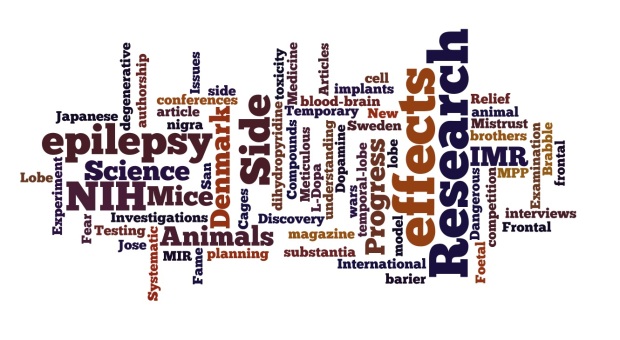On Wednesday (26 February) the students worked in groups to discuss chapters 4-6. I asked them to create a poster with four sections: Summary, Response to Issues, Questions, and Topics we Should Study. Pictures of the posters are below.
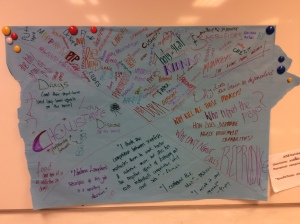
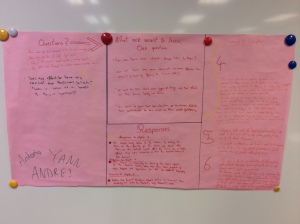

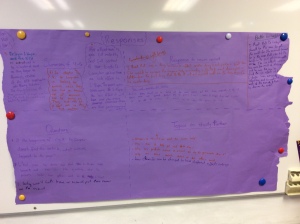
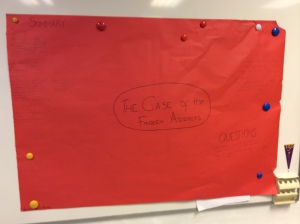

The students are now working on Blog Post Number 2. This blog post is much more open-ended than the previous blog post that was simply a summary of chapters 1-3 with a few small extras. The blog post needs to address and discuss any issue raised in chapters 4-6. There are numerous issues that can be discussed, such as animal testing, the “ego battle” between scientists to get published and the decision by Dr. Burns to take the Silvey brothers to NIH without consulting Dr. Langston.
One programming note: As of the writing of this post (on 28th February), my students are working on these blog posts. I’ll update this post when they start to get published by the students. The due date is March 12th.
Below is an example of a blog post I created as a model – and just for fun, actually. The students, however, were encouraged to delve into other topics as well.
What’s more important?
Within chapter 5 of The Case of the Frozen Addicts (Langston and Palfreman), a bit of an ego battle develops between Dr. Langston and the scientists of NIH. A few years prior to the cases in the Bay Area that Dr. Langley investigated, a paper was written about aspiring designer drug maker Barry Kidston. With the new cases in the Bay Area, NIH is now very interested in taking over the investigation. Dr. Langston is hesitant to relinquish control of his patients. In fact, he says a few times that he is a clinician first and a researcher second; his patients’ welfare is priority number one. But Dr. Langston is aware of the opportunity he has to move to the cutting edge of research on Parkinson’s Disease. With the researchers from NIH wrangling for access to his patients and the leftever drugs from the frozen addicts, Dr. Langston has to make a decision: Do I collaborate, or do I handle this myself? After consulting a respected friend and colleague, he decides to work together with the NIH to move science forward. He recognizes that NIH has far more access to resources.
This leads me to ponder two thoughts. First, did Dr. Langston make the right decision? And second, is it typical for scientists to have ‘research wars’ in an effort to get published first? And do these research wars come at the cost of collaboration that would lead to more discoveries?
The first question is actually one that I’m curious about as I read further in the book. Will Dr. Langston ever regret his agreement to work directly with NIH? Or will he end up gaining experience with one of the premiere research facilities in the world and benefit from the collaboration? My prediction: Dr. Langston will regret his decision because he will feel as though he loses control of his patients and the research. I can’t wait to read more to find out!
The idea to discuss the second topic of collaboration amongst scientists developed a bit serendipitously. The day before I was reading the chapter on “research wars” in Frozen Addicts, I came across FX’s blog. I’m always looking for new chemistry blogs to follow, and this blog was mentionedin my Twitter timeline. So I started following him. Needless to say, his second blog post – Evolution of Chemistry Writing Over 5 Decades (Part 1) – had perfect timing. His post discusses the changing nature of published articles in the science literature. His conclusion of the first set of histograms, “There is a clear trend towards papers with longer author lists, with the average number of authors increasing from 2.4 (in 1961) to 5.3 (in 2011).” (Coudert, “Evolution of Chemistry Writing Over 5 Decades (Part 1).) Dr. Langston has his paper rejected by a prestigious journal because he had too many authors. This was in the mid-1980s. FX’s data shows that longer author lists are becoming the norm today. Maybe Dr. Langston’s work would have been published with the longer author list and he wouldn’t have felt compelled to collaborate with NIH. The second set of histograms shows the number of institutions represented in papers over the decades. The trend here is clear as well: There is an increase in the number of papers that have authors collaborating between different institutions. This set of data suggests that Dr. Langston made the right decision, to join a collaboration with scientists from another institute (NIH).
What are your thoughts on these issues? I’d love to have some discussion about this issue here.
Works Cited
Coudert, François-Xavier. “Evolution of Chemistry Writing Over 5 Decades (Part 1).” FX’s blog: musings on chemistry, among other things… Web. 28 Feb 2014.
Langston, J. William, and Jon Palfreman. The Case of the Frozen Addicts. New York: Pantheon, 1995. Print.
Update
Below are links to student blogs that have completed blog post number 2. Please drop by their blogs and make comments. Engage them in conversation about the book. Thank you.
http://antoninhoscienceaisb423.wordpress.com

